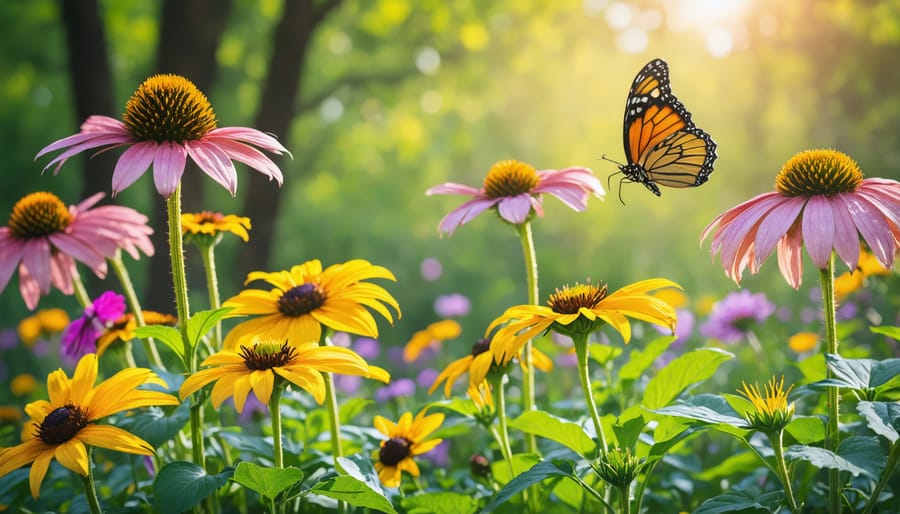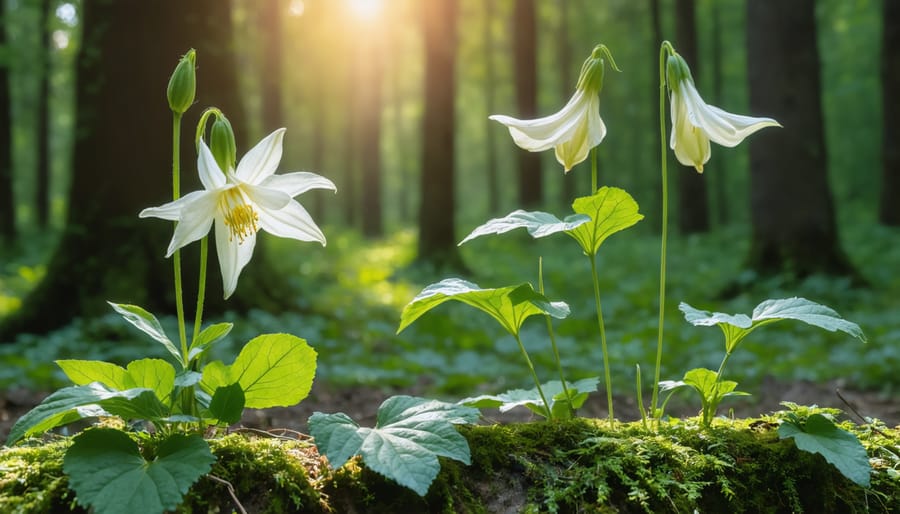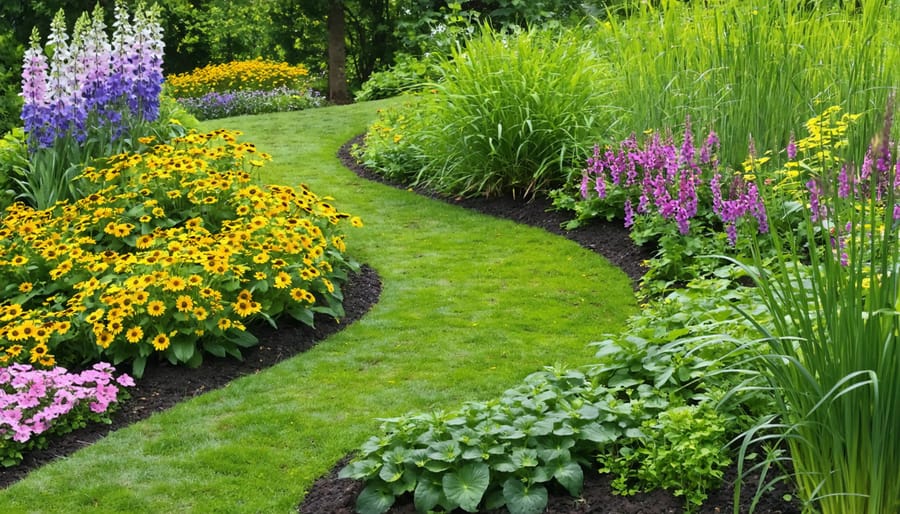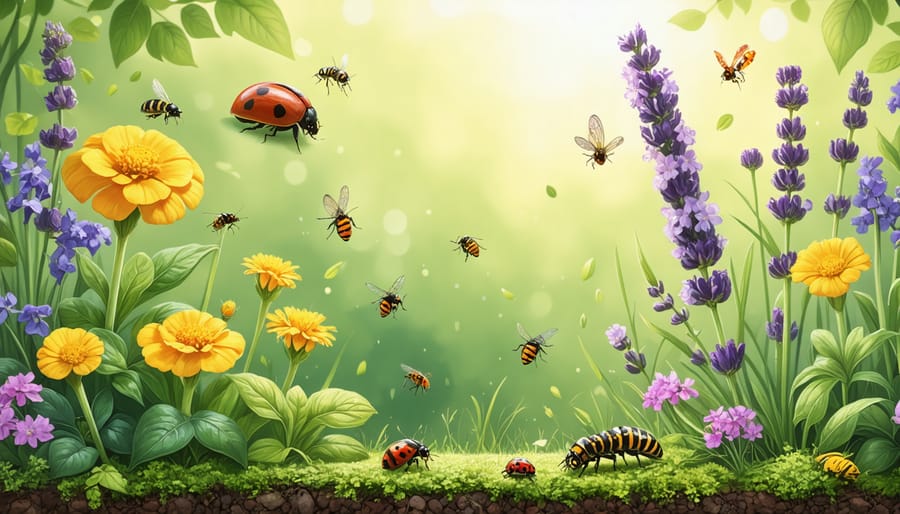Transform your Minnesota garden into a stunning local flora showcase with hardy native perennials that thrive in our challenging climate while supporting essential pollinators and wildlife. Purple coneflower, butterfly weed, and wild bergamot establish deep root systems that withstand both drought and harsh winters, requiring minimal maintenance once established. Group these resilient natives according to their moisture needs—placing moisture-loving Joe Pye weed and cardinal flower in low-lying areas, while positioning prairie smoke and little bluestem in well-drained spots. By selecting native perennials adapted to Minnesota’s unique growing conditions, you’ll create a sustainable landscape that returns year after year with increasing vigor, providing continuous blooms from spring through fall while naturally resisting local pests and diseases. Whether you’re working with a sunny prairie garden or a shaded woodland setting, these indigenous plants offer the perfect solution for every Minnesota garden space.
Sun-Loving Prairie Stars
Purple Coneflower and Black-Eyed Susan
Purple Coneflower and Black-Eyed Susan are two of Minnesota’s most beloved native perennials, bringing vibrant colors and beneficial wildlife to any garden. These hardy plants have been decorating our prairies for centuries and are perfect for both novice and experienced gardeners.
Purple Coneflower (Echinacea purpurea) stands tall with its distinctive purple-pink petals and spiky center cone, blooming from June through August. This drought-tolerant plant thrives in full sun and well-drained soil, reaching heights of 2-4 feet. Beyond its beauty, Purple Coneflower serves as a vital nectar source for butterflies and bees, while its seedheads provide winter food for goldfinches and other birds.
Black-Eyed Susan (Rudbeckia hirta) offers cheerful yellow blooms with dark brown centers from July through September. Growing 1-3 feet tall, these sturdy flowers are incredibly adaptable and can handle various soil conditions, though they prefer full sun. They’re excellent for mass plantings and naturalized areas, creating stunning drifts of color that require minimal maintenance.
Both plants work beautifully together in prairie-style gardens and make excellent cut flowers. They’re resistant to deer and rabbit damage, and their strong root systems help prevent soil erosion. For the best results, plant them in spring or early fall, spacing them 18-24 inches apart. These resilient beauties will multiply over time, creating an increasingly impressive display year after year.

Blazing Star and Butterfly Weed
Blazing Star and Butterfly Weed are two of Minnesota’s most captivating native perennials, beloved by both gardeners and pollinators alike. Blazing Star (Liatris spicata) produces striking purple spikes that reach heights of 2-4 feet, creating vertical interest in summer gardens. These hardy plants thrive in full sun and adapt well to various soil conditions, though they prefer well-draining soil.
Butterfly Weed (Asclepias tuberosa) lives up to its name by attracting countless butterflies with its vibrant orange blooms. This drought-tolerant plant grows 1-2 feet tall and puts on a spectacular show from early to mid-summer. Both species are excellent choices for prairie-style gardens and pollinator habitats.
To establish these natives, plant them in spring after the last frost. Space Blazing Star plants about 12-15 inches apart and Butterfly Weed 18-24 inches apart. Both plants develop deep taproots, making them drought-resistant once established but challenging to transplant later.
Maintenance is refreshingly simple: remove spent blooms to encourage longer flowering periods and cut back stems to ground level in late fall or early spring. Neither plant requires frequent division, and both are remarkably resistant to deer and rabbits. These low-maintenance beauties offer reliable performance year after year while supporting local ecosystem health.
Remember to leave some stems standing through winter, as they provide important shelter for beneficial insects and add winter interest to your garden.
Woodland Wonders

Wild Columbine and Jack-in-the-Pulpit
Wild Columbine and Jack-in-the-Pulpit are two of Minnesota’s most enchanting native woodland flowers, each bringing its own unique charm to shady garden spaces. Wild Columbine (Aquilegia canadensis) delights gardeners with its nodding, red and yellow blooms that appear in late spring, dancing above delicate, blue-green foliage. These graceful flowers are especially beloved by hummingbirds and make excellent additions to woodland gardens or partially shaded borders.
These hardy perennials prefer rich, well-draining soil and dappled shade, though they can tolerate more sun in cooler areas. Wild Columbine will readily self-seed, creating natural colonies that add whimsy to your garden without becoming invasive.
Jack-in-the-Pulpit (Arisaema triphyllum) is a fascinating woodland native that gets its name from its distinctive hooded flower structure. The “Jack” is actually a spadix that stands upright within the protective purple-striped green spathe, or “pulpit.” Later in the season, the flowers transform into clusters of bright red berries, providing visual interest well into fall.
These woodland treasures thrive in moist, rich soil and deep shade. Plant them among ferns and other shade-loving perennials for a natural woodland garden feel. Both plants are relatively low-maintenance once established and are naturally deer-resistant, making them excellent choices for Minnesota gardens where wildlife visits are common.
Wild Geranium and Bloodroot
As winter releases its grip on Minnesota’s landscape, Wild Geranium and Bloodroot emerge as early harbingers of spring, delighting gardeners and providing crucial early-season support for native pollinators. These woodland gems are perfectly adapted to our climate and offer both beauty and ecological benefits to your garden.
Wild Geranium (Geranium maculatum) showcases delicate pink-purple blooms from April through June, creating a lovely carpet of color beneath trees or in partially shaded garden spots. Its deeply lobed leaves add texture throughout the growing season, and the plant’s clumping nature makes it an excellent choice for preventing soil erosion on gentle slopes.
Bloodroot (Sanguinaria canadensis) is among the first native perennials to bloom, often pushing through late snow with its pristine white flowers wrapped in silvery-green leaves. Each flower opens like a star in the morning sun, attracting early-emerging bees and other pollinators. The plant gets its name from its orange-red sap, which Native Americans historically used for dye and medicinal purposes.
Both species naturally grow in woodland settings and prefer rich, well-draining soil with partial shade. They’re incredibly low-maintenance once established and will gradually spread to form beautiful colonies. These early bloomers pair wonderfully with other spring ephemerals like Virginia Bluebells and provide essential food sources for native bees emerging from winter dormancy.

Four-Season Garden Planning
Spring to Summer Succession
Creating a vibrant succession of blooms from spring through summer is a crucial aspect of successful perennial garden design, especially in Minnesota’s unique climate. Start your spring display with early bloomers like Wild Columbine (Aquilegia canadensis) and Prairie Smoke (Geum triflorum), which emerge as soon as the snow melts. These hardy natives provide essential early-season nectar for pollinators.
As spring progresses, incorporate mid-season bloomers like Wild Lupine (Lupinus perennis) and Golden Alexander (Zizia aurea). These beauties bridge the gap between early spring and summer, ensuring continuous color in your garden. Their sturdy stems and vibrant blooms create stunning natural displays that perfectly complement earlier blooming species.
For summer, plan layers of blooming times with favorites like Purple Coneflower (Echinacea purpurea), Wild Bergamot (Monarda fistulosa), and Black-Eyed Susan (Rudbeckia hirta). These summer standouts provide weeks of color and attract countless butterflies and bees. Consider mixing heights and bloom times – tall Joe Pye Weed (Eutrochium purpureum) can tower behind medium-height Blazing Star (Liatris spicata), while shorter Prairie Coreopsis (Coreopsis palmata) fills in the foreground.
To maintain continuous blooming, group plants in clusters of three to five, and arrange them so that as one variety begins to fade, another reaches its peak. Remember to deadhead spent blooms regularly to encourage extended flowering periods and prevent unwanted self-seeding.
Fall Colors and Winter Interest
Minnesota gardens don’t have to fade into obscurity when autumn arrives. In fact, many native perennials offer stunning fall colors and winter interest that can keep your garden vibrant year-round. The rich golds of Brown-Eyed Susans persist well into fall, while Little Bluestem grass transforms from blue-green summer hues to striking copper-orange autumn colors that dance in the winter wind.
Prairie Dropseed is another excellent choice, forming neat mounds of fine-textured foliage that turns golden-orange in fall and maintains its structure throughout winter. The seed heads of Purple Coneflower and Joe Pye Weed not only provide food for birds but also create beautiful silhouettes when dusted with snow.
For dramatic late-season color, New England Aster produces masses of purple blooms in September and October, while Smooth Blue Aster offers lovely lavender flowers that contrast beautifully with autumn’s warm palette. Both plants’ dried stems add vertical interest to the winter landscape.
Don’t overlook the beauty of native grasses. Switch Grass develops a vase-like shape that stands up to winter weather, its seed heads catching light and creating magical moments on frosty mornings. Northern Sea Oats produces decorative seed heads that persist through winter, creating gentle rustling sounds in winter breezes.
For ground-level interest, Wild Geranium’s foliage turns brilliant red in fall, while Prairie Smoke’s feathery seed heads create an ethereal effect when backlit by low winter sun. These hardy natives not only provide multi-season appeal but also support local wildlife during the harshest months of the year.
Remember to leave dried stems and seed heads standing through winter – they’ll protect plant crowns from harsh weather while providing shelter for beneficial insects and food for winter birds.
Success Tips for Native Gardens
Creating a successful native garden starts with proper planning and site preparation. Before planting, take time to analyze your soil conditions and sunlight exposure. Most Minnesota native perennials prefer well-draining soil, so consider adding organic matter if your soil is heavy clay or compacted.
Start small and expand gradually – this allows you to learn what works in your space without feeling overwhelmed. Group plants with similar water and light requirements together to make maintenance easier. When selecting plants, consider their mature size and spacing needs to prevent overcrowding as they grow.
Proper timing is crucial for planting success. Spring and fall are ideal seasons for establishing native perennials in Minnesota. Fall planting gives roots time to develop before winter, while spring allows plants to establish before summer heat arrives. Follow a comprehensive season-by-season care plan to keep your garden thriving throughout the year.
Water deeply but infrequently to encourage deep root growth. While native plants are generally drought-tolerant once established, they need regular watering during their first growing season. Apply a layer of organic mulch around plants to retain moisture and suppress weeds, but avoid piling it against plant stems.
Don’t be too quick to deadhead spent blooms – many native plants provide important seeds for birds and winter interest in the garden. Leave some plant material standing through winter to provide shelter for beneficial insects and natural mulch protection.
Remember that native gardens may look slightly wild compared to traditional landscapes. Embrace this natural aesthetic while maintaining clean edges and defined borders to create a intentional, managed appearance that neighbors will appreciate. With proper care and patience, your native garden will mature into a beautiful, low-maintenance landscape that supports local wildlife and reflects Minnesota’s natural heritage.
Native perennials are truly the unsung heroes of Minnesota gardens, offering a perfect blend of beauty, sustainability, and ecological value. By choosing these remarkable plants, you’re not just creating a stunning landscape – you’re actively supporting local wildlife, conserving water, and preserving our state’s natural heritage.
These hardy plants reward gardeners with years of reliable blooms while requiring minimal maintenance once established. Their deep root systems help prevent soil erosion and improve water quality, making them an environmentally conscious choice for any garden. Plus, the money and time you’ll save on watering, fertilizing, and replacing plants can be spent enjoying your garden instead of constantly maintaining it.
Remember that every native garden, no matter how small, makes a difference. Whether you start with a few Black-Eyed Susans in your front yard or transform your entire landscape with Prairie Blazing Stars and Purple Coneflowers, you’re contributing to a larger movement of ecological restoration and biodiversity.
Ready to start your native garden journey? Begin by selecting plants that match your site conditions and personal preferences. Consider joining local native plant societies or attending workshops to connect with fellow gardening enthusiasts. Your efforts will help create a more sustainable and beautiful Minnesota, one garden at a time.
Take that first step today – your garden, local wildlife, and future generations will thank you for choosing native perennials.




